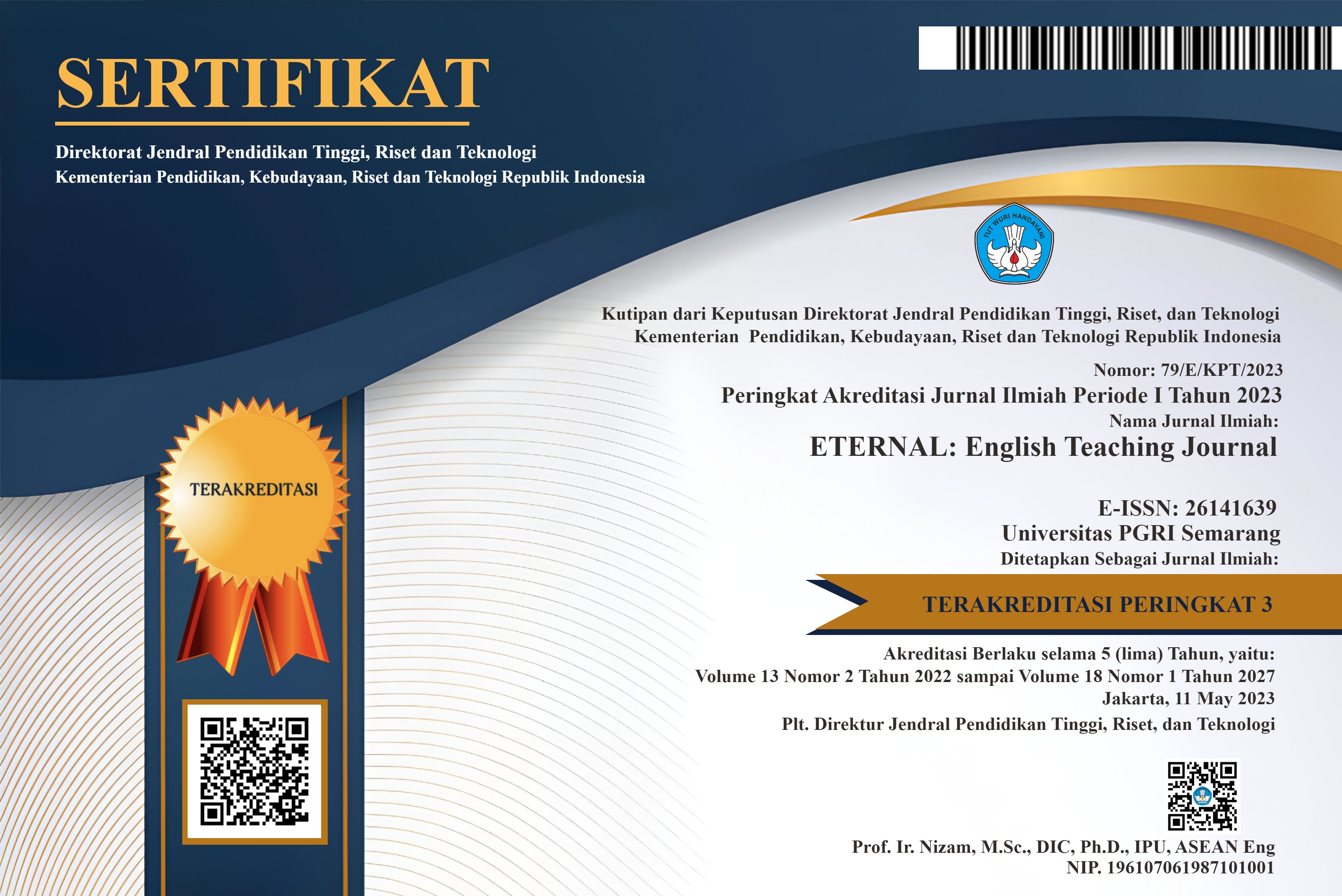Improving Students’ English Grammar Through Incorporating Games
DOI:
https://doi.org/10.26877/eternal.v15i1.322Keywords:
Incorporating game, Grammar, simple present tenseAbstract
This classroom action research aimed to enhance English grammar learning at a junior high school level by incorporating game-based activities, focusing on the simple present tense. The primary objective was to address identified challenges, such as low student enthusiasm and understanding of grammatical concepts. The study used classroom action research, unfolded in three cycles, each refining the game-based approach based on insights from the previous cycle. The methodology involved pre-tests, game-based lessons, observations, and reflective assessments. Results demonstrated sustained improvements, with increased scores and active participation. Key findings indicated enhanced active participation, motivation, concept understanding, collaboration, spontaneous English use, and a deeper understanding of the game-based method's shortcomings. The time required for understanding they were varied, reflecting the effectiveness of scaffolding in the learning environment. Implications of the research suggest the continued integration of game-based approaches, recognizing the diverse learning needs of students. Teachers should tailor scaffolding strategies to individual ZPDs, fostering collaboration and addressing language apprehension. The study contributes to the broader discourse on effective language teaching methodologies, emphasizing the dynamic interplay of theory and practice in the language learning classroom.
References
References
Birks, M., & Mills, J. (2014). Qualitative methodology: A practical guide. Qualitative Methodology, 1-288.
Brown, H. D. (2014). Principles of Language earning and Teaching : A Course in Second Language Acquisition.
Deci, E. L., & Ryan, R. M. (1985). Intrinsic Motivation and Self-Determination in Human Behavior. In Jurnal Penelitian Pendidikan Guru Sekolah Dasar (1st Edition, Vol. 6, Issue August). Springer.
Dörnyei, Z., & Ushioda, E. (2011). Teaching and Researching Motivation. Pearson Education Limited.
Ellis, R. (2012). Language Teaching Research and Language Pedagogy. In Language Teaching Research and Language Pedagogy. https://doi.org/10.1002/9781118271643
Gardner, H. (2011). Frames of Mind The Theory of Multiple Intelligence. In Experiments With People. Basic Books.
Krashen, S. (1989). Language Acquisition and Language Education - Extensions and Applications. In Prentice Hall International (pp. 1–146). Pergamon Press.
Kubota, R., & Lehner, A. (2004). Toward critical contrastive rhetoric. Journal of Second Language Writing, 13(1), 7–27. https://doi.org/10.1016/j.jslw.2004.04.003
Larsen-Freeman, D., & Anderson, M. (2011). Techniques-Principles-Language-Teaching. Oxford University Press.
Larsen-Freeman, D. (2019). Teaching Language: From Grammar To Grammaring. Heinle & Heinle Publishers.
Lightbown, P. M., & Spada, N. (2006). How Languages are Learned. Oxford.
Mills, G. E. (2018). Action Researcl Teacher Researcher. Pearson.
Piaget, J. (1952). The origins of intelligence in children. International Universities Press.
Richards, J. C., & Rodgers, T. S. (2014). Approaches and Methods in Language Teaching. Cambridge University Press.
Schon, D. A. (1983). The reflective practitioner: How professionals think in action. Basic Book.
Scrivener, J. (2011). Learning teaching: The essential guide to English language teaching.
Stringer, E. (2014). Action Research in Education. In International Encyclopedia of Education, Third Edition. Pearson Education Limited.
Ur, P. (2013). Grammar Practice Activities - A Practical Guide for Teachers. Cambridge University Press.
Vygotsky, L. (1978). Mind and Society. Harvard University Press.







